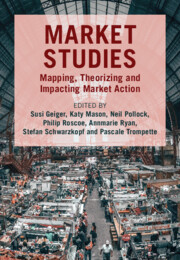Book contents
- Market Studies
- Market Studies
- Copyright page
- Contents
- Figures
- Tables
- Contributors
- Acknowledgements
- Introduction: The Multiple Pasts, Presents and Futures of Markets and Market Studies
- Part I Market Designs and Market Misfires
- Part II Post-Performative Approaches to Studying Markets
- Part III Valuation
- Part IV Markets in Motion: Places and Spaces
- Part V The Secret Life of Market Studies Methods
- Part VI Broadening the Perspectives in Market Studies
- Part VII Future (Im)Perfect Markets
- Chapter 28 Digital Platforms and (Im)Perfect Market Futures
- Chapter 29 Reconfiguring Visibility and Participation in a Digitalizing World
- Chapter 30 Market Futures and the Role of Market Studies in the Making of Circular Economies
- Chapter 31 Making Room for Care in Markets and in Market Studies
- Index
- References
Chapter 30 - Market Futures and the Role of Market Studies in the Making of Circular Economies
from Part VII - Future (Im)Perfect Markets
Published online by Cambridge University Press: 22 November 2024
- Market Studies
- Market Studies
- Copyright page
- Contents
- Figures
- Tables
- Contributors
- Acknowledgements
- Introduction: The Multiple Pasts, Presents and Futures of Markets and Market Studies
- Part I Market Designs and Market Misfires
- Part II Post-Performative Approaches to Studying Markets
- Part III Valuation
- Part IV Markets in Motion: Places and Spaces
- Part V The Secret Life of Market Studies Methods
- Part VI Broadening the Perspectives in Market Studies
- Part VII Future (Im)Perfect Markets
- Chapter 28 Digital Platforms and (Im)Perfect Market Futures
- Chapter 29 Reconfiguring Visibility and Participation in a Digitalizing World
- Chapter 30 Market Futures and the Role of Market Studies in the Making of Circular Economies
- Chapter 31 Making Room for Care in Markets and in Market Studies
- Index
- References
Summary
This chapter explores how Market Studies scholars can usefully direct their expertise and attention to the complex challenges thrown up by the required shift to the imaginary circular economy. We propose a framework and research agenda for the infrastructuring moves required to fundamentally shift the sociomaterial, technical, political and economic arrangements that sit below our linear economy, in order to reconfigure how our economy works. The need for greater fungibility at a local, regional, national and international scales, and for new forms of governance are seen as critical to success. However, while Market Studies scholars are well-equipped to address these challenges, we need to do more than simply deploy existing conceptual frameworks and tools, asking, what demands do circular economy concerns place upon Market Studies? We argue that theories of materiality and valuation need to be extended if not reformulated, to accommodate many of the features associated with circularity. We recommend that scholars engage more actively with understanding the infrastructures of supply and demand that compose the linear economy, the practices that sustain that demand, and the practices of repair, remanufacturing, retrofitting, upgrading, and enabling new modalities of access to goods.
Information
- Type
- Chapter
- Information
- Market StudiesMapping, Theorizing and Impacting Market Action, pp. 485 - 498Publisher: Cambridge University PressPrint publication year: 2024
